When Is the Best Time to Visit the Silk Road in China?
The Silk Road in China, part of the massive ancient network of trade routes that stretched from China to Europe, ran from its starting point in Xi’an and passed through three separate provinces in China. The route passed through several towns and cities along the way, including Lanzhou, Jiayuguan, and Dunhuang in Gansu Province and Turpan, Urumqi, and Kashgar in Xinjiang Uyghur Autonomous Region.
With the crossing of three provinces, the weather along the Silk Road largely depends on which part of it you are traveling along. The diverse geography and altitudes of the route make for very different weather patterns as you progress west from Xi’an, from warm and comfortable to dry and windy.
General Weather Condition along the Way
At the heart of China, in the center of the Guanzhong Plain, Xi’an is a temperate city, with a mild monsoon climate. With hot rainy summers and cold dry winters, Shaanxi is best visited in the shoulder seasons from March to May and September to November.
Gansu Province has a very different climate, due to the complex geography and changing elevations. The rainy season comes from June to September, making the spring months from April to June the best time to visit. By October it is already getting colder, and the winter can be as cold as minus twelve degrees.
As the route travels west it passes through Xinjiang, which has a semi-arid desert climate with very low rainfall. With little rain, the best time to travel along the Silk Road in Xinjiang is from April to October, when the weather is warmest and there is little rain.
While these are the ideal seasons for each area, it is actually possible to start your China Silk Road tour at any time of the year, if you are well prepared for the weather conditions. However, you need to be aware that there are parts of the route that can get extremely cold in the winter months, making travel harder. That said, seeing the ground covered in frost and ice in the mornings when you wake up with a crisp blue sky above makes it worthwhile.
Visit in Spring
Spring in China is not always the same from one place to another. The sheer vastness of the country means that there are multiple climate conditions across the country, and the weather can be different from one province to another.
In Shaanxi, spring is brief and dry, with the colder weather taking its time to go, and then quickly giving way to the warmer summer months. March to May is the spring season, when there is little rain and the weather is starting to get warmer. In Gansu, the climate is a little colder, though the spring months from March to May are still the same, Colder nights still prevail during the spring, and thick clothing is needed in the mornings and evenings as the temperature change from day to night is quite high.
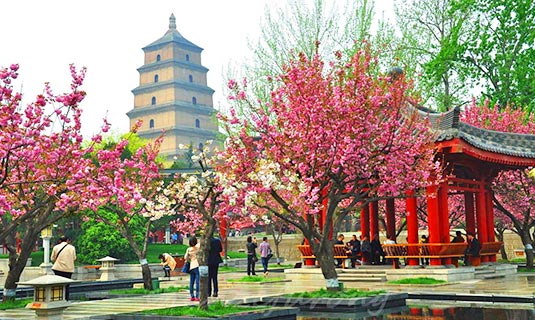
Spring is the best season to appreciate blossom
In Xinjiang, the climate is completely different, with spring being rather short, but very dry. The arid desert climate means that it is warm during the day and cold at night, making warm clothes a necessity. Spring along the Silk Road is a great time to travel, as the new growth and spring blooms are out by mid-April, and the weather is not too cold to be comfortable. There are also a few festivals to visit that will give you and insight into the people of Xinjiang.
The best festival to stop at is the Nuoruz Festival at the end of March; New Year in the Persian calendar. Many of the minorities in Xinjiang are of Islam faith, and the New Year is celebrated throughout the province. The celebrations include singing and dancing, wrestling, games and kite flying, and many others. The festival name comes from the Iranian word for “Spring Water”, and is linked to the vernal equinox.
Visit in Summer
Summer is the ideal time to travel the whole length of the Silk Road, with hot weather for the entire trip. In Shaanxi, the summer is hot and humid, and runs from June to August. It is the time of the monsoon in Shaanxi’s Guanzhong Plain, though the rain is not as heavy and frequent as in the more tropical regions of Asia. In Gansu, the rainy summer runs from June to September, with high temperatures of around 20-24 degrees in July, the hottest month. The temperatures do vary across Gansu Province, and the hottest destination of Gansu tour is around the area of Dunhuang, which can see temperatures rising to around 30 degrees, with only a little rain.

Grape Festival in Summer of Xinjiang
Xinjiang in summer is a hot and dry place to visit, with average temperatures well above 35 degrees. June, July, and August are the hottest months of the year, and are also a great time to see the Grape Festival, as well as many of the summer flowers and fruits that bloom and ripen in the heat of summer. Held in Turpan every year at the end of August, the Grape festival is a traditional celebration of the area’s main produce, as well as a celebration of life itself. It is popular in the area to hold your wedding on the days of the Grape Festival, and traditional Uygur weddings can be found all over the city.
Sun cream, moisturizers, and lip balm are a necessity when traveling along the Silk Road in summer, as the hotter weather can be damaging to the skin. A good hat is also useful, and you need to bring your sunglasses against the bright sun, especially in the arid desert areas of Xinjiang.
Visit in Autumn
As the year moves on, so does the weather, and with autumn comes the falling leaves and cooler weather. September to November is the autumn season along most of the Silk Road, and the weather everywhere has one thing in common; it is starting to get cooler.
In Shaanxi Province, the autumn is somewhat dry and brief, quickly giving way to the colder winter months, though even those are not really that cold. It is, however, a dry season, and the leaves begin to turn brown on the trees, making it a great time to travel. In Gansu, the weather is similar, although a lot colder, especially at night, when temperatures can drop to around 3-4 degrees by the end of November.
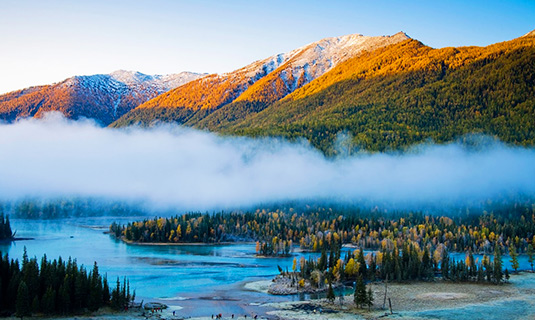
Kanas Lake in the autumn of Xinjiang
In Xinjiang, the autumn season is the golden season and time to harvest much of the fruit that has spent the summer growing. The weather has begun to cool, in reparation for winter, and the skies are clear and bright, making it the perfect time to visit the province.
>>Join the 9-day northern Xinjiang tour with Kanas Lake to enjoy the enchanting autumnal scenery
For the Muslims of the province, autumn is the time of one of the most celebrated festivals in Islam, the Corban Festival. Known around the rest of the world as Eid al-Adha, it occurs at the beginning of October, and is the Festival of Sacrifice. One of the three greatest festivals in Islam, it is a time of pilgrimage, and the offering of sacrifice.
Visit in Winter
No matter where you go in China in winter, you are going to find it cold. How cold, depends on which part of China you are in, and the same can be said for the length of the Silk Road in China. The farther west you travel, the colder the winter is going to be.
The winter in Shaanxi is mild in comparison with that of Xinjiang, though for the area it is cold and dry. Not too cold that you cannot tour the silk road, though. While the temperatures at night can get as low as 3-4 degrees, with some warm clothing the tour can be quite confortable, and the dry climate and clear bright skies are a pleasant sight as you travel along the route.
Gansu is a little harsher than Shaanxi in winter, with temperatures getting as low as -12 degrees at night. It can get as low as minus fifteen degrees in some areas of western Gansu, and the winters are long and cold, but dry and bright. January is the coldest month, and it is a good idea to bring plenty of warm clothing if you are traveling in the winter.

Enjoying skiing and snowboarding during Snow Festival in Xinjiang
Xinjiang in winter is not normally somewhere you would want to be, as the weather can be very cold and long. With average temperatures of around -15 degrees throughout the three months of winter, the cold is penetrating and requires some extreme weather gear. However, the fresh bright air and clear skies are worth braving the cold for. The scenery in winter around Urumqi and Turpan is stunning. In Kashgar, the winter is short, although still with an average temperature of around -6 degrees.
Winter in Xinjiang is the time of the Ice and Snow Festival, and the area has its own winter tourism industry based around the winter sports such as skiing and snowboarding. Consisting of the classic winter sports, the festival is a celebration of the winter solstice, and regularly sees many thousands of visitors attending the skiing and boarding in the area through December and January.
If you are intending to visit Xinjiang in the winter, it is a good idea to pack for alpine winter climates, as the weather can get quite cold, despite the bright sunshine. Gloves and hats are the order of the day, and bring your sunglasses or a pair of snow goggles to reduce the glare that can cause snow-blindness.
Related Articles and Posts
Related Trips
-
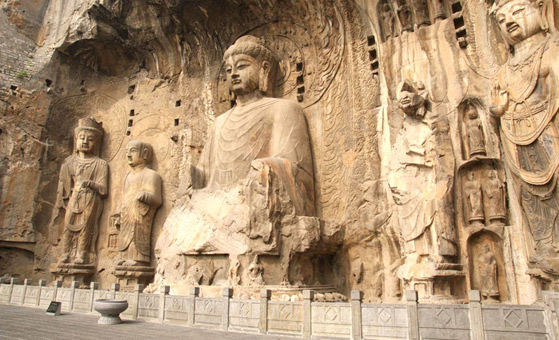 4-Day Jiayuguan Pass and Dunhuang Silk Road Short BreakView Details
4-Day Jiayuguan Pass and Dunhuang Silk Road Short BreakView DetailsJiayuguan - Dunhuang
-
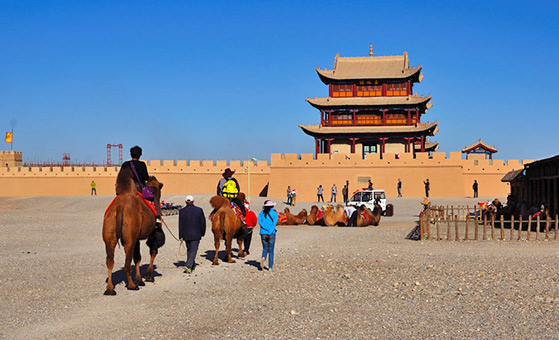 8-Day Lanzhou Xiahe Jiayuguan Dunhuang Silk Road TourView Details
8-Day Lanzhou Xiahe Jiayuguan Dunhuang Silk Road TourView DetailsLanzhou - Xiahe - Lanzhou - on the train - Jiayuguan - Dunhuang
-
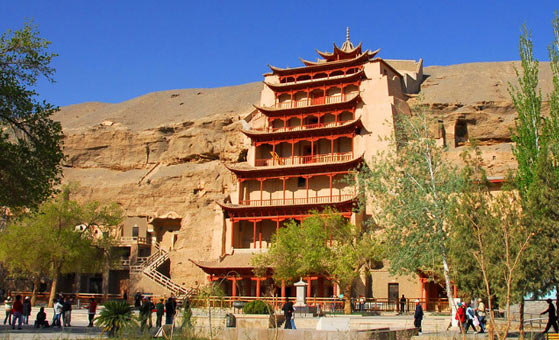 10-Day Highlights of the China Silk Road TourView Details
10-Day Highlights of the China Silk Road TourView DetailsDunhuang - on the train - Turpan - Urumqi - Kashgar - Taklamakan Desert Camp - Kashgar - Urumqi
Ask a Quick Question
 BACK
BACK

 We, the 3rdpoletour, are the pioneer of in-depth Sichuan tour. We commit to offer you the most professionaltour service to facilitate your Sichuan travel.
We, the 3rdpoletour, are the pioneer of in-depth Sichuan tour. We commit to offer you the most professionaltour service to facilitate your Sichuan travel. 

0 Comments ON “When Is the Best Time to Visit the Silk Road in China?”